The Challenges
Our client, a life sciences company, was looking to implement a new and improved field training program within its pharmaceutical sales organization.
They planned to select one high-potential sales representative from each region to be trained and certified. Each new field trainer would support their regional sales manager in educating the sales team, onboarding new sales reps, mentoring colleagues to help them improve their sales performance, and helping to pull through important change initiatives out in the field.
The objective was to enhance sales team performance while also providing a career development opportunity for those selected field trainers. This came with several challenges.
#1: Motivation
We ask a lot of field trainers, given that training is not their primary role. In this case, they are sales representatives who are performing these additional training responsibilities in their spare time, on top of their normal workload, sometimes taking time away from pursuing their own sales goals.
If these field trainers are not intrinsically motivated, it is unlikely that they will put in the time and effort required to make an impact on their regional sales team, even when given a modest stipend.
#2: Distance
Regional field trainers who work in Sales are out in the field, physically dispersed across the country, not in an office or manufacturing site. This makes it expensive and logistically challenging to bring them together through in-person events. They also have little contact with each other and with cross-functional colleagues.
Each of them will be out on an island, metaphorically speaking, supporting different people and needing to figure things out for themselves.
#3: Ability
Any selected field trainers are likely to be high performers with strong selling skills, product knowledge, and clinical acumen, but they are unlikely to have the skills of a professional trainer or mentor. For example, many will lack the public speaking and facilitation skills to get up in front of their peers and lead a training session. They are also likely to have gaps in giving feedback and conducting peer coaching conversations, because they have never been in a situation where they are expected to coach anyone.
The Solution Architecture
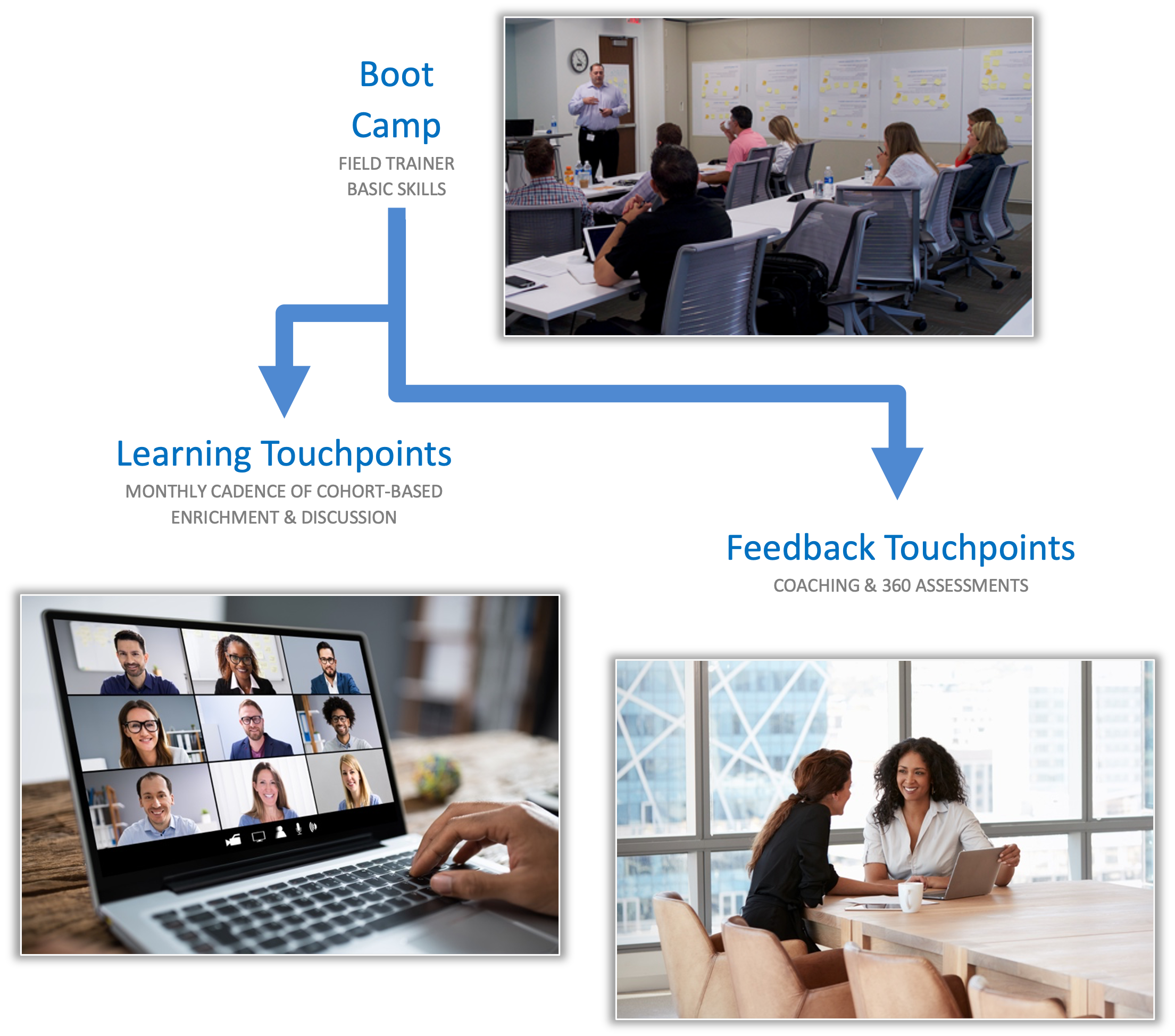
Part 1: Boot Camp
When a field trainer gets started, their manager may need them to interview a prospective new hire, onboard a new hire, support a change initiative, mentor a low-performing peer, or facilitate a team training session. Since each region has different needs at different times, we cannot send field trainers out ill-equipped.
Therefore, we’ve found that the most effective approach is to pull new field trainers together for an intensive boot camp experience, where they learn the basics of delivering training, providing feedback during field rides, interviewing, and onboarding. This ensures that regardless of what their managers need them to do immediately, they have a basis for getting started.
In this case, the boot camp lasted 2.5 days and was offered as an in-person experience, then later run as a series of live virtual sessions (due to travel restrictions).
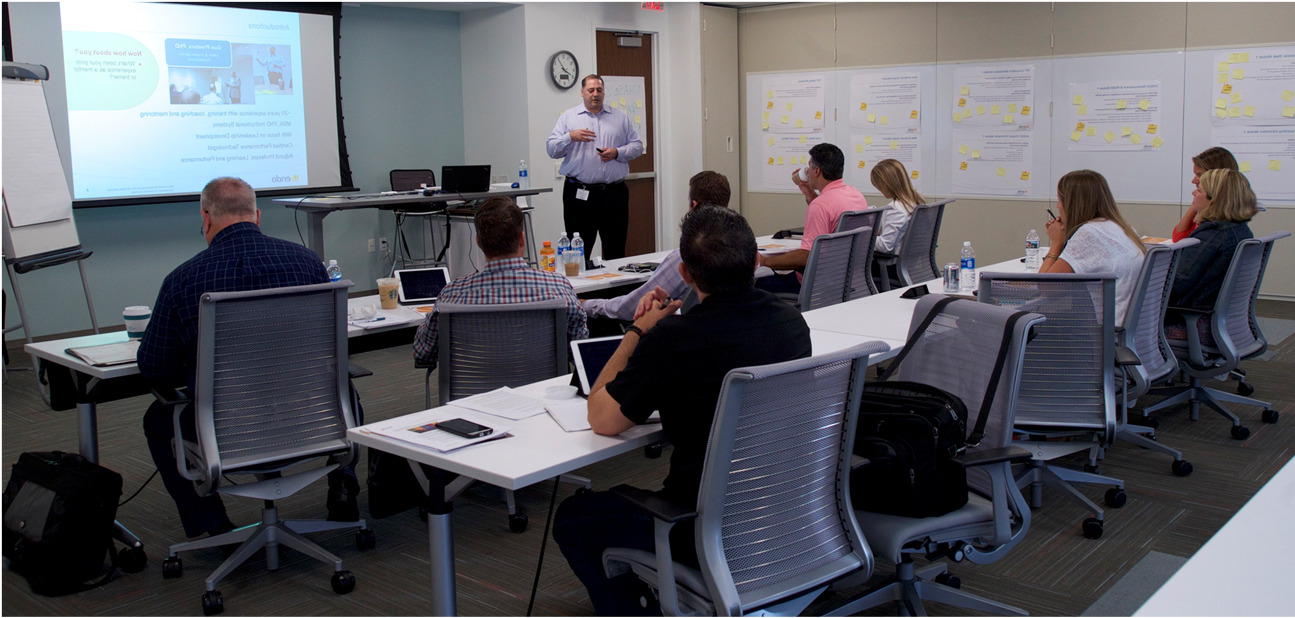
- Field Trainer Playbook: During the boot camp, participants were given an interactive PDF document called the Field Trainer Playbook, which helped them stay organized as they worked through the program. It described for them month by month what they would be expected to complete, including prework, virtual sessions, coaching touchpoints, and post-work. It also acted as a workbook, providing them with reflection questions and assignments that they could complete within the document. This one-stop-shop approach helped the field trainers stay on top of things.
- Interviewing & Onboarding Guides: These particular field trainers would be asked to help their managers interview candidates and onboard new hires, so we developed step-by-step guides to help field trainers with both of these responsibilities. The onboarding guide provided to new hires helped reduce the load for field trainers and laid out a structured journey for them to follow. These guides also contained answers to FAQs and links to company resources, which helped to reduce the need for scavenger hunts each time a question arose.
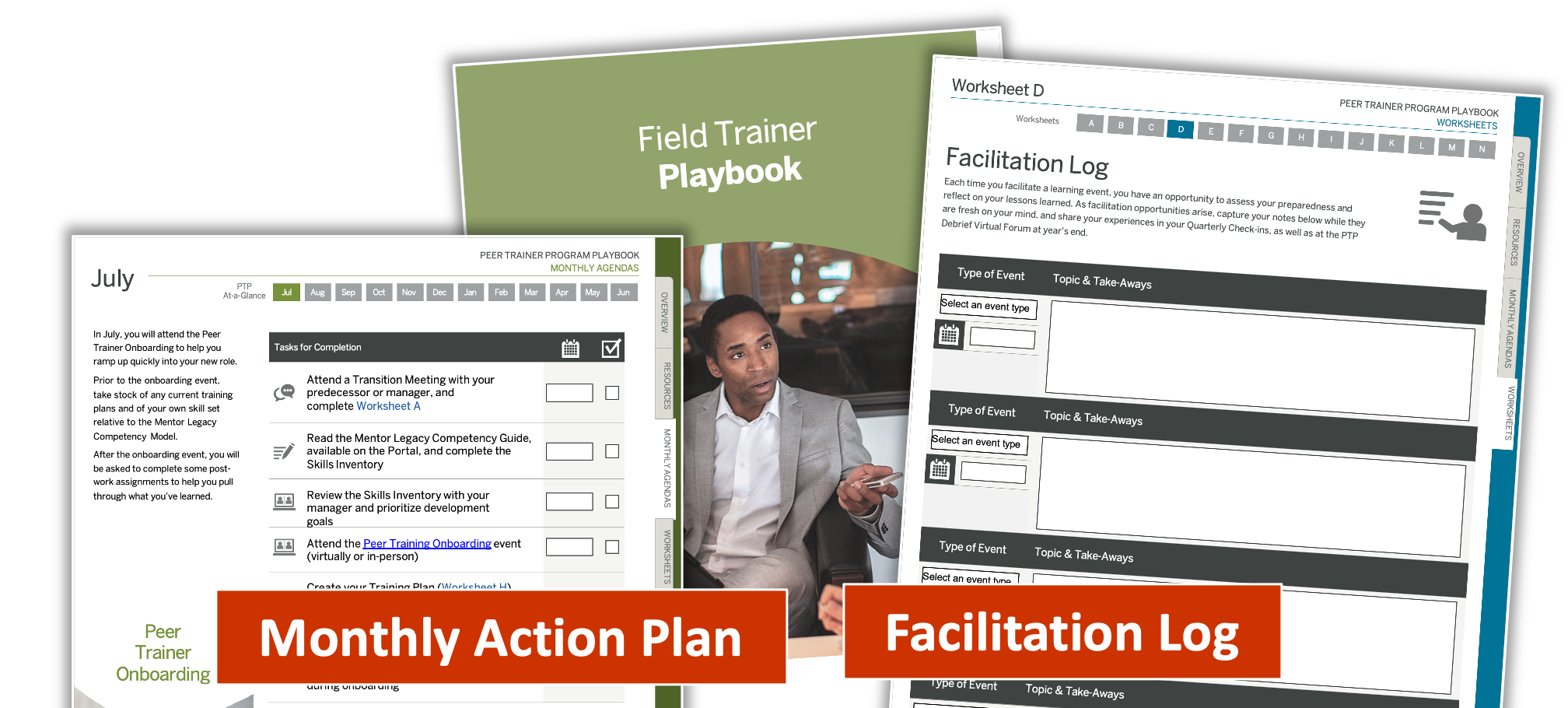
Field Trainer Playbook
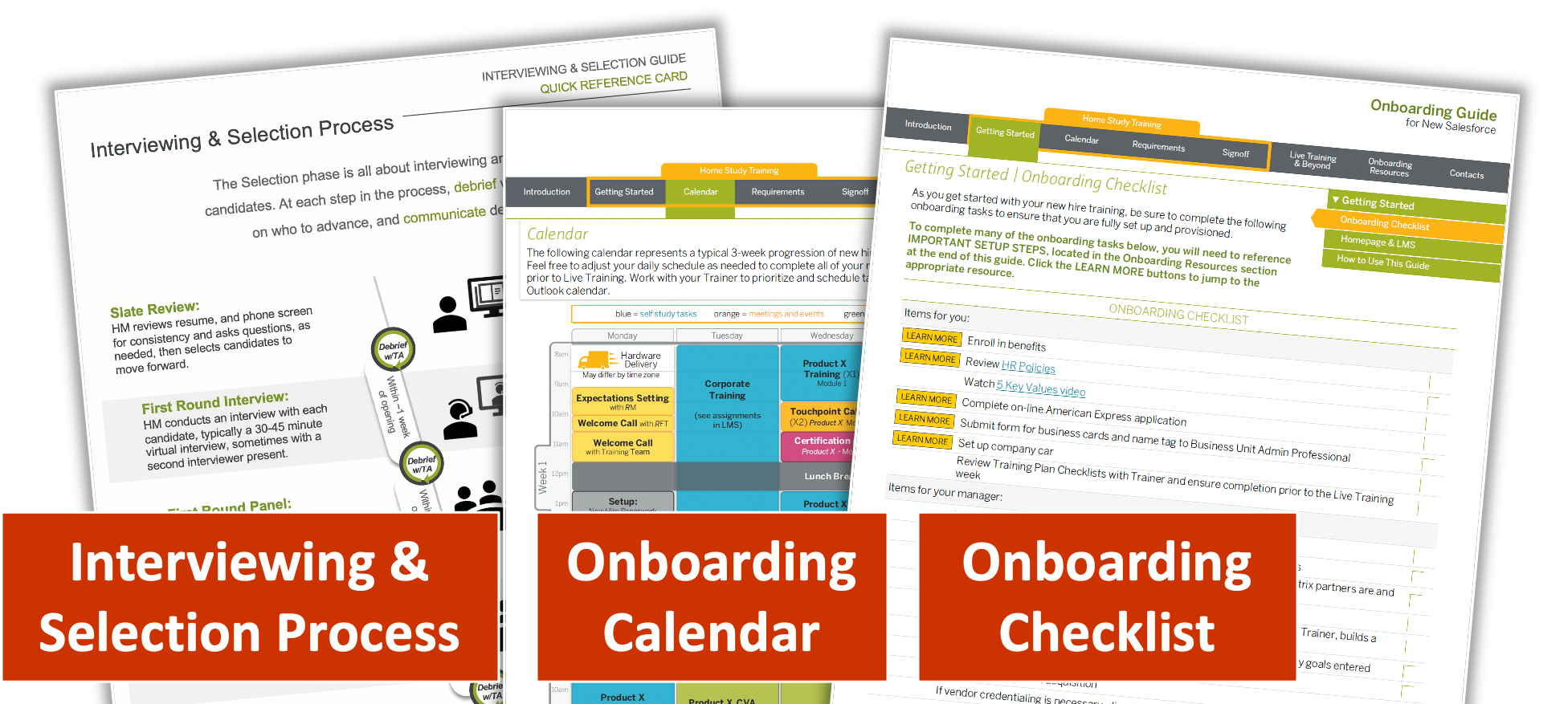
Interviewing & Onboarding Guides
Part 2: Learning Touchpoints
The month after the boot camp experience, participants began attending a series of live 90-minute virtual training sessions.
Monthly 90-Minute Virtual Sessions: Each monthly session focused on a critical success skill, such as influencing without authority, courageous conversations, change leadership, delivering feedback, and storytelling. Most sessions included about 30 minutes of new content followed by 60 minutes of problem-solving, brainstorming and discussion activities. Below are a few examples.
- Your Mentor Legacy: In this session, we leverage Prestera FX’s proprietary Mentor Legacy competency model and its supporting resources as a means of helping new participants understand the skills required to be successful field trainers. Through scenario-based discussions, we helped them anticipate many of the challenges they would encounter in the field and develop strategies for overcoming them. The Mentor Legacy Guide included a self-assessment tool that they could use to take stock of their current skill set, discuss with their manager, and identify development opportunities to include in their individual development plans.
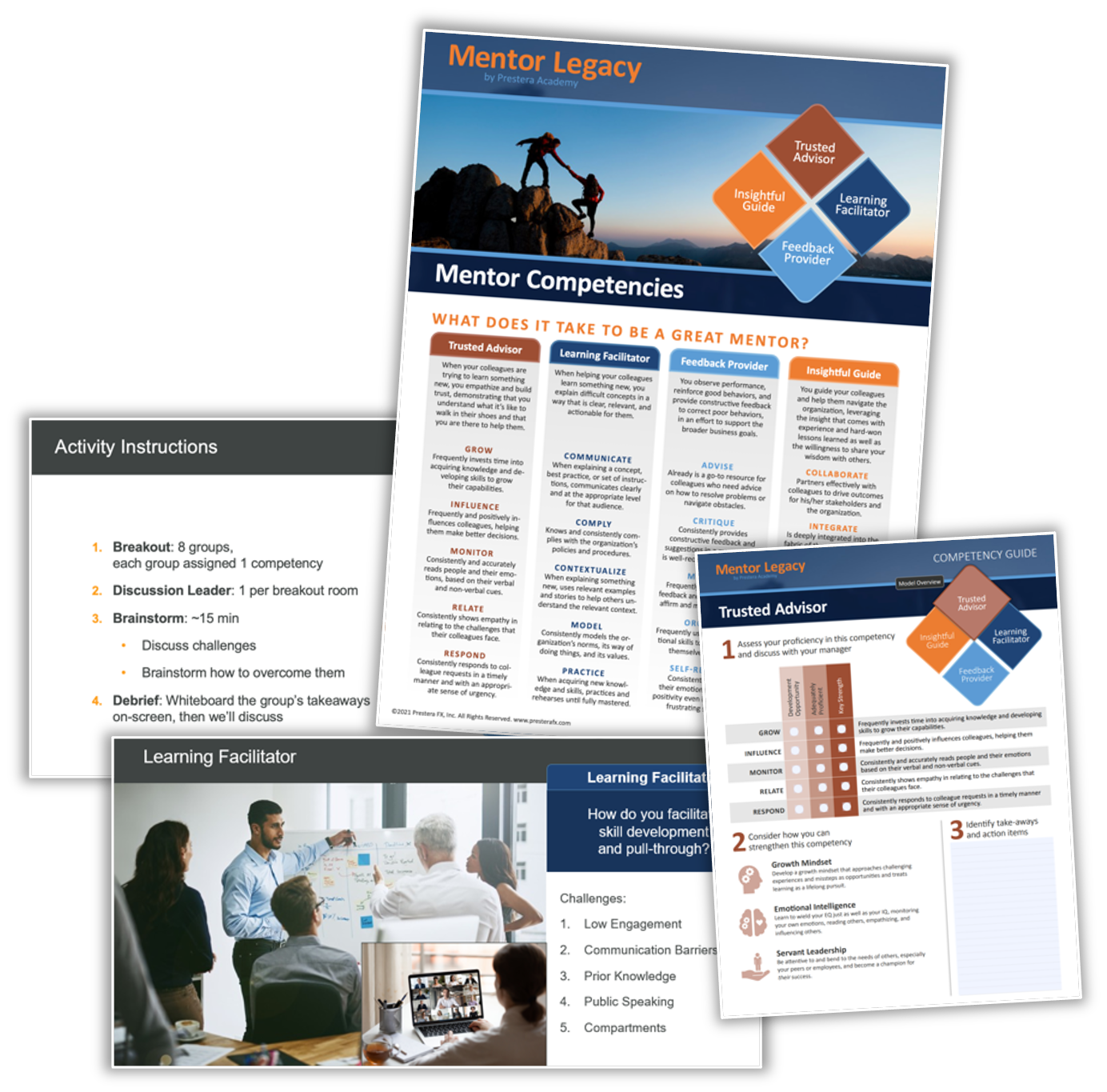
Materials from the Mentory Legacy session
- Leading Without Authority: In this session, we leveraged Cialdini’s Six Shortcuts to Persuasion as a framework for discussing how field trainers can earn the right to influence their fellow sales reps.
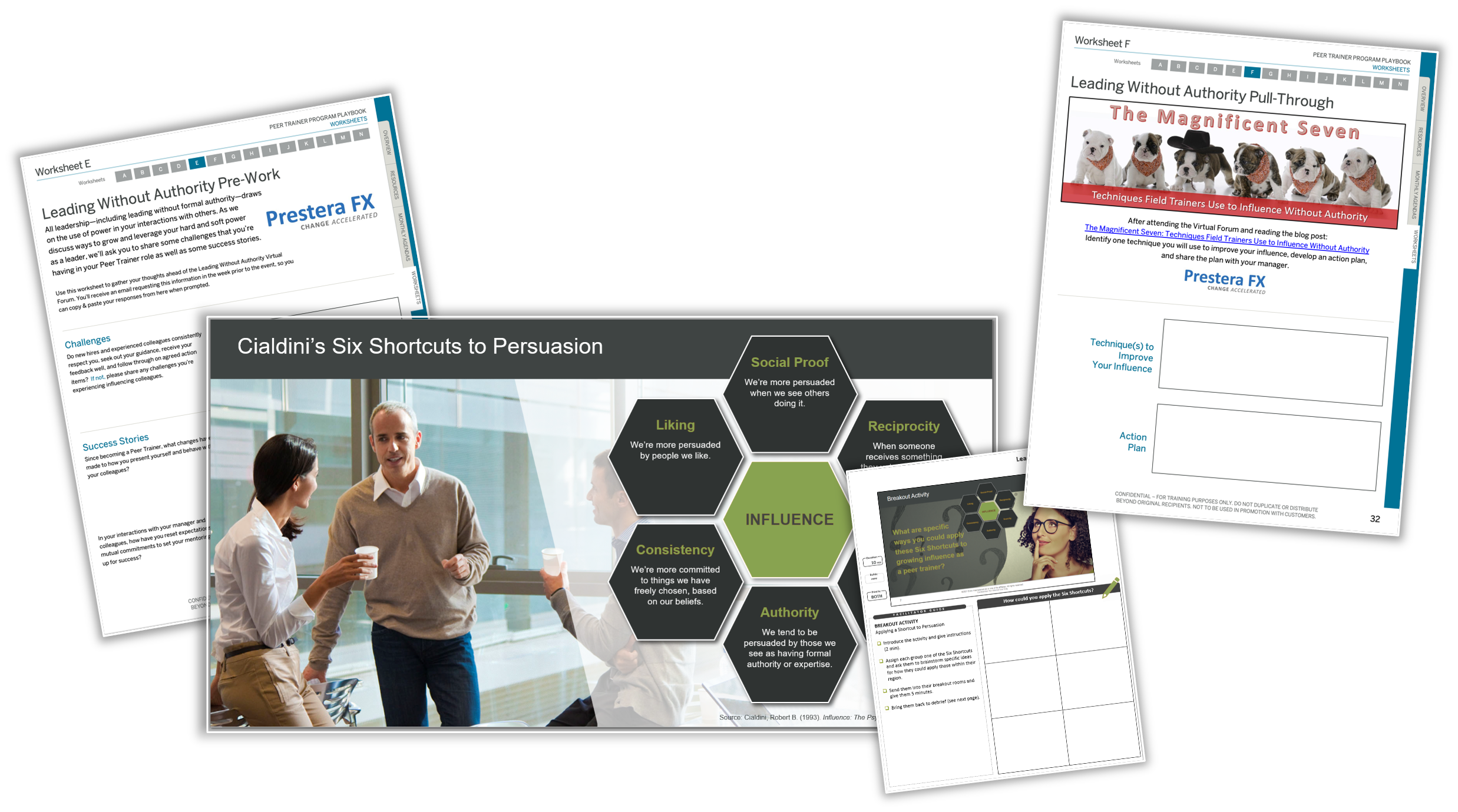
Materials from the Leading Without Authority session
- Courageous Conversations: In this session, we leveraged the Crucial Conversations model and our own content to lead a scenario-based discussion on how to engage in difficult conversations around issues that require a bit of courage to confront.
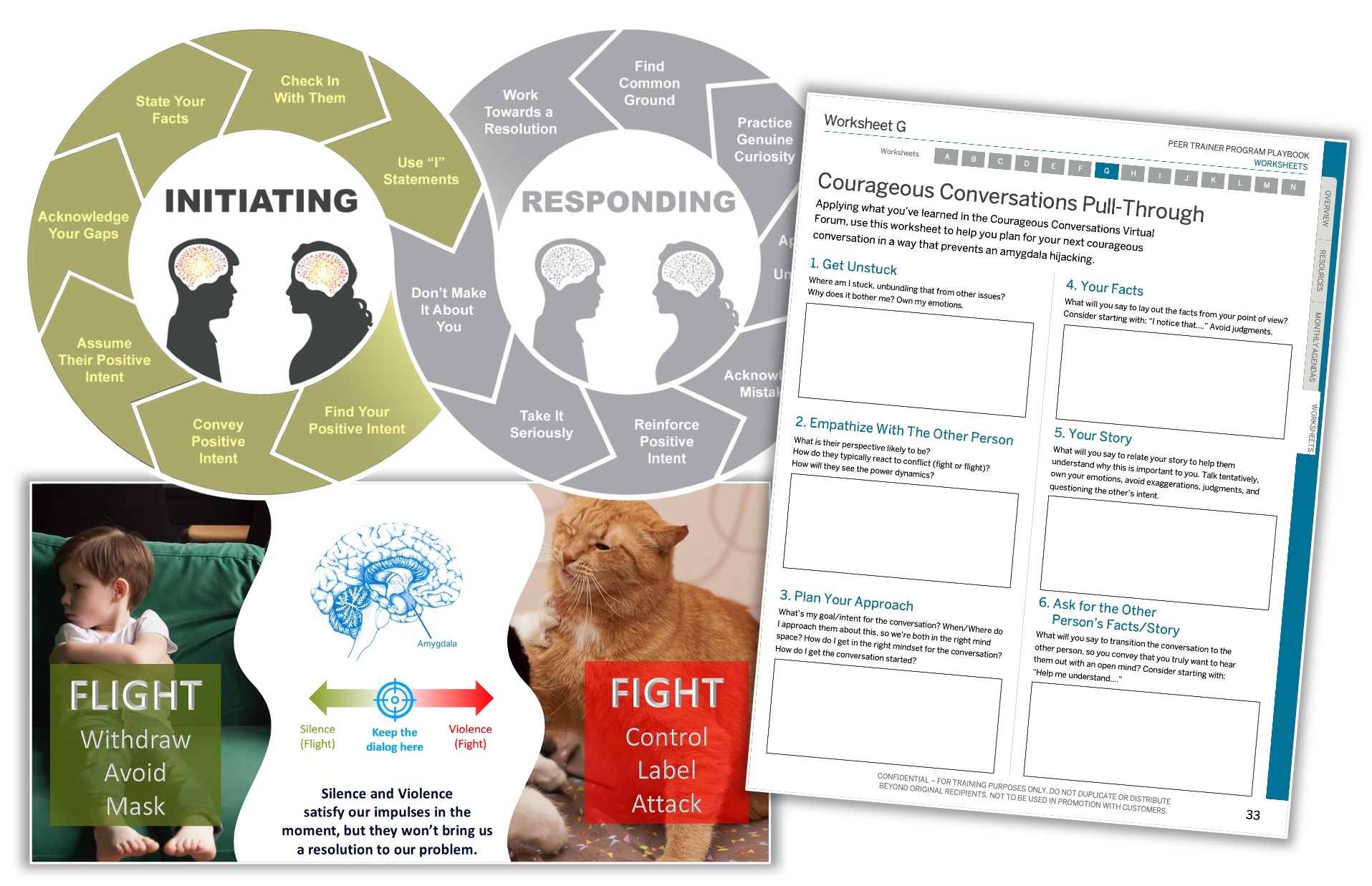
Materials from the Courageous Conversations session
Part 3: Feedback Touchpoints
To ensure that participants were properly motivated to fulfill their part-time duties as field trainers, we positioned this one-year assignment as a career development opportunity and put the appropriate feedback mechanisms in place to shape participants into emerging leaders.
In fact, once this program was in place, it became a natural feeder of high potentials into a formalized emerging leader program. Developing future leaders started here.
Manager Coaching: In the playbooks, participants were asked to meet with their managers at least every other month to discuss their professional growth as field trainers and potential leaders. In this first touchpoint, participants and their managers were asked to conduct a skills inventory leveraging the Mentor Legacy Guide and discuss where the participant’s best development opportunities lay.
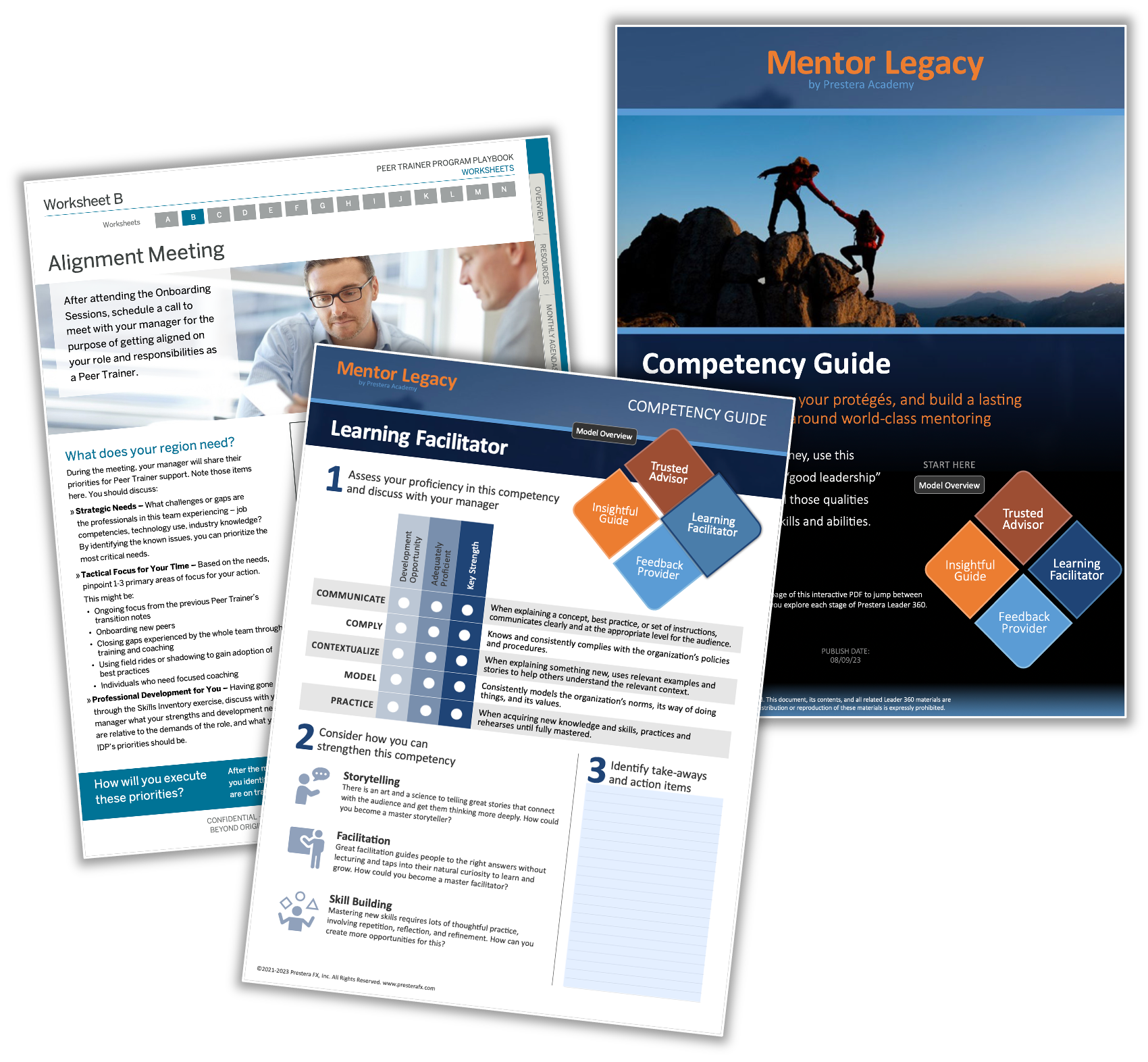
Mentor Legacy Competency Guide
360 Assessments: Each participant was offered the opportunity to go through a 360-degree assessment process. Their manager, colleagues, and the peers they were training would complete a survey, then the participant, their manager, and their L&D Coach would review the report together. This 360, which was offered twice during their tenure, gauged both Mentor Legacy skills as well as well leadership traits and derailers.
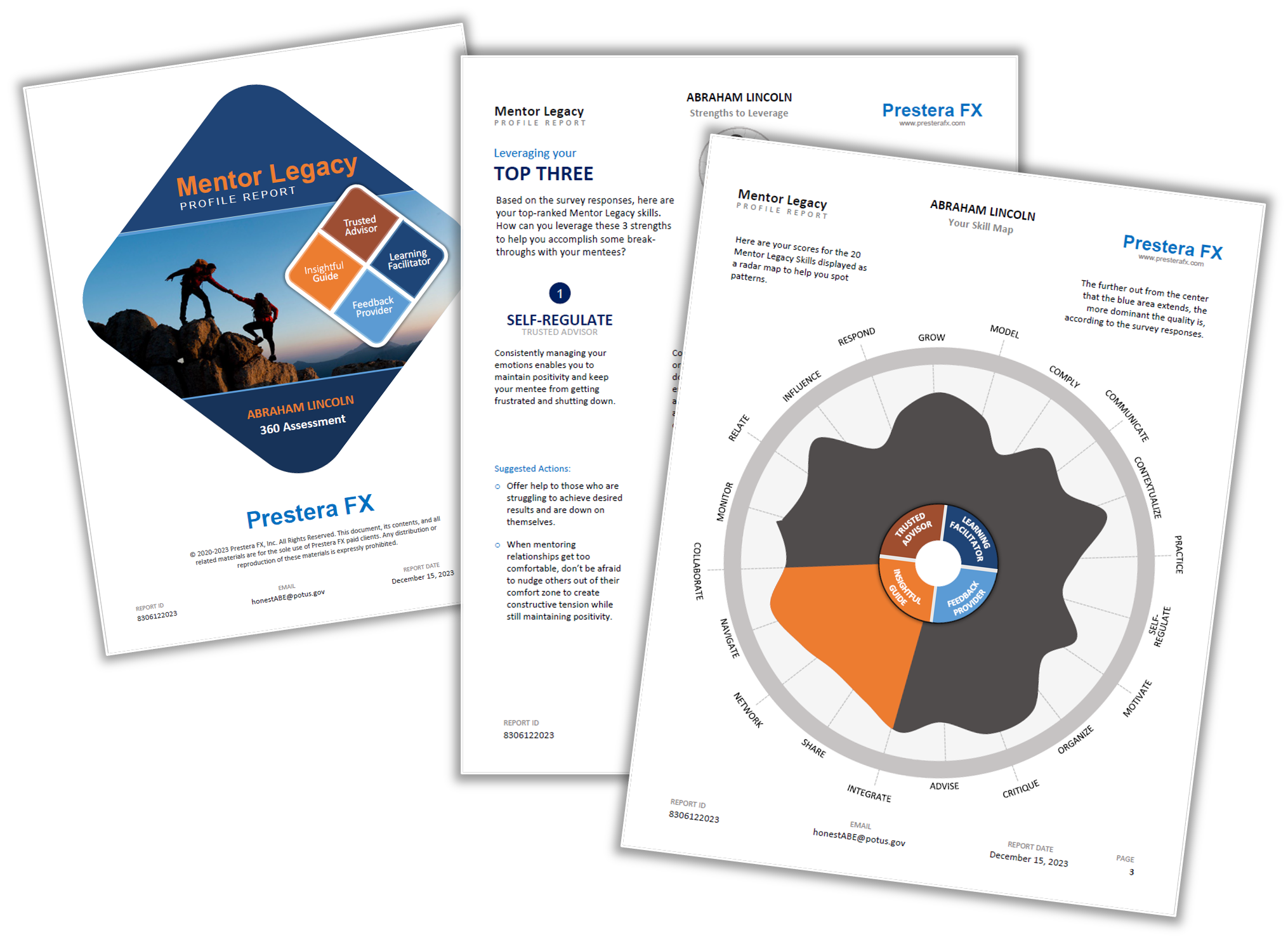
360 Assessment Report
Capstone Assignments: Each participant was asked to complete a series of immersive activities during their field trainer tenure.
The first part of it involved taking the handoff of the region’s training plan from their field trainer predecessor. They would then need to execute against that plan while they ramped up and started developing their own training plan, which would overlap with their successor. Training plans could include mentoring assignments, training workshops they could deliver to their regional team, onboarding new hires, and involvement in national sales meetings.
At the end of their tenure, they would meet with and transition the plan to their successor. In that final month, participants were asked to deliver a presentation to their leadership team, summarizing their contributions and the progress that their regional team had made over that period.

Capstone Project Worksheets
“The field trainer and emerging leader programs have become feeders for our talent pool, and 100% of our new Sales Leaders have come from these programs over the past 6 years.”
Design Principles at Work
This case study illustrates the real-world application of four performance-based instructional design principles:
- Technical Certification As Career Development: When designing technical certifications, we tend to think of them as being discrete modules that need to be able to stand alone; and while they do, they can also serve a higher purpose within the organization. In this case study, participants were significantly more motivated to learn the skills needed and to follow through on their field trainer responsibilities, because they saw this program as a career development opportunity that would help them achieve their broader aspirations. We could have simply focused on the field trainer skill set, but instead we looked beyond this temporary role and started them on the road toward becoming emerging leaders who could use this 1-year assignment as a springboard to other opportunities. That attracted the right kind of participants and fueled their motivation to succeed in the role.
- Maximizing Relevance to the Job: Rather than trying to turn these field trainers into full-fledged L&D professionals, we focused on helping them gain the knowledge and skills that were most crucial to the types of assignments they would get from their managers and the types of situations they would find themselves in. For example, helping to interview and select sales reps is not normally part of a trainer’s responsibility, but these field trainers would be expected to contribute in that way, so we made sure that they were equipped for conducting candidate field rides and afterwards evaluating candidates. By staying closely aligned with the job responsibilities, we ensured that our curriculum’s relevance was maximized and that we never wasted time with nice-to-know things.
- Immersion and Feedback Systems: Both in the boot camp and in the monthly virtual sessions, participants had many opportunities to apply, practice, and collaborate with the help of real-world field trainer scenarios and case studies. In between sessions, participants completed prework and post-work assignments that challenged them to reflect on what they were learning relative to their real-world experiences and to develop action plans for how they could do their work differently as a result of the training. Likewise, during their monthly coaching sessions, they were challenged to reflect on their field trainer work and how they could approach it differently. The two 360 assessments gave them feedback from the people they were working most closely with every day. As many commented, the program didn’t feel like training so much as “intensively mindful work experience,” as one field trainer described it.
- A Focus on Job Performance – Not Just Learning: Participants were responsible for developing and implementing their region’s training plan—another skill they learned in the program—and used that plan to drive improvements across the regional sales team. They were also heavily involved in the execution of national sales meetings as well as the pull-through after those meetings. This close relationship between job performance and learning experience had a profound impact. Ultimately, the success of the program was assessed in terms of the impact on each regional team’s performance—sales goal achievement—as well as retention and engagement. Participants summarized their contributions and impact during their capstone presentations. It became evident that the sales managers with strong field trainers experienced substantial improvement in all three areas. Sales managers with less effective field trainers quickly realized how important it was to select the right person for the job and to work closely with them.
Taken together, these principles help to make performance-based instruction a rich and powerful way to maximize relevance and engagement, deliver the right performance support at the right time to the right people, and achieve skill transfer levels that significantly impact business outcomes.
We’d love to hear your perspective on this and other ways to make workplace training more effective and impactful.

